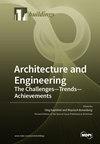Impact of Night Ventilation on Indoor Thermal Environment of Residential Buildings under the Dual Carbon Target: A Case Study of Xi’an
IF 3.1
3区 工程技术
Q2 CONSTRUCTION & BUILDING TECHNOLOGY
引用次数: 0
Abstract
Effectively reducing the energy consumed by buildings under the dual carbon targets in China was our focus in this study. We used experimental methods to test and analyze the indoor air and average radiation temperatures in a specific apartment building in Xi’an. We compared the impact of night ventilation on the indoor thermal environment using the EnergyPlus software V9.5.0. The results showed that night ventilation is suitable for the typical summer temperatures in Xi’an when the daily temperature range is larger than 6 °C. Night ventilation technology can be used for 76 days from June to August, accounting for approximately 82.6% of this period. The indoor air and average radiation temperatures both decrease with the adoption of night ventilation, with these temperatures decreasing with an increase in the daily temperature range. When the daily temperature range increases from 3 °C to 15 °C, night ventilation can reduce the indoor average and radiation temperatures by a maximum of 1.07 and 0.47 °C, respectively, on typical meteorological days. When the daily temperature range is 15 °C, the maximum energy savings is 4.85 kWh/d, and the cost saving index for air conditioning operation is 0.065 CNY/(m2·d). With a daily temperature range of 3 °C, the air conditioning operating costs are reduced by 63.7%. Our study provides a reference for building energy conservation and the creation of comfortable indoor thermal environments under the dual carbon target: a carbon peak before 2030 and carbon neutrality before 2060.双碳目标下夜间通风对居住建筑室内热环境的影响:西安案例研究
在中国的双碳目标下,有效降低建筑能耗是本研究的重点。我们采用实验方法对西安某公寓楼的室内空气温度和平均辐射温度进行了测试和分析。我们使用 EnergyPlus 软件 V9.5.0 比较了夜间通风对室内热环境的影响。结果表明,当日温差大于 6 ℃ 时,夜间通风适用于西安典型的夏季气温。从 6 月到 8 月,有 76 天可以采用夜间通风技术,约占这一时期的 82.6%。采用夜间通风技术后,室内空气温度和平均辐射温度均有所下降,且随着日温差的增大而下降。当日温范围从 3 °C 增加到 15 °C 时,在典型气象日,夜间通风可使室内平均气温和辐射温度分别最多降低 1.07 °C 和 0.47 °C。当日温范围为 15 °C 时,最大节能效果为 4.85 kWh/d,空调运行成本节约指数为 0.065 CNY/(m2-d)。当日温差为 3 ℃ 时,空调运行成本降低了 63.7%。我们的研究为在 2030 年前达到碳峰值和 2060 年前实现碳中和的双碳目标下,建筑节能和创造舒适的室内热环境提供了参考。
本文章由计算机程序翻译,如有差异,请以英文原文为准。
求助全文
约1分钟内获得全文
求助全文
来源期刊

Buildings
Multiple-
CiteScore
3.40
自引率
26.30%
发文量
1883
审稿时长
11 weeks
期刊介绍:
BUILDINGS content is primarily staff-written and submitted information is evaluated by the editors for its value to the audience. Such information may be used in articles with appropriate attribution to the source. The editorial staff considers information on the following topics: -Issues directed at building owners and facility managers in North America -Issues relevant to existing buildings, including retrofits, maintenance and modernization -Solution-based content, such as tips and tricks -New construction but only with an eye to issues involving maintenance and operation We generally do not review the following topics because these are not relevant to our readers: -Information on the residential market with the exception of multifamily buildings -International news unrelated to the North American market -Real estate market updates or construction updates
 求助内容:
求助内容: 应助结果提醒方式:
应助结果提醒方式:


